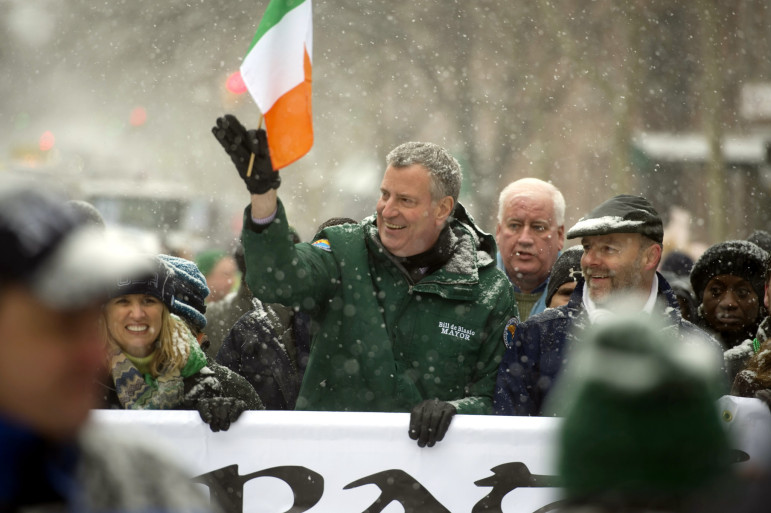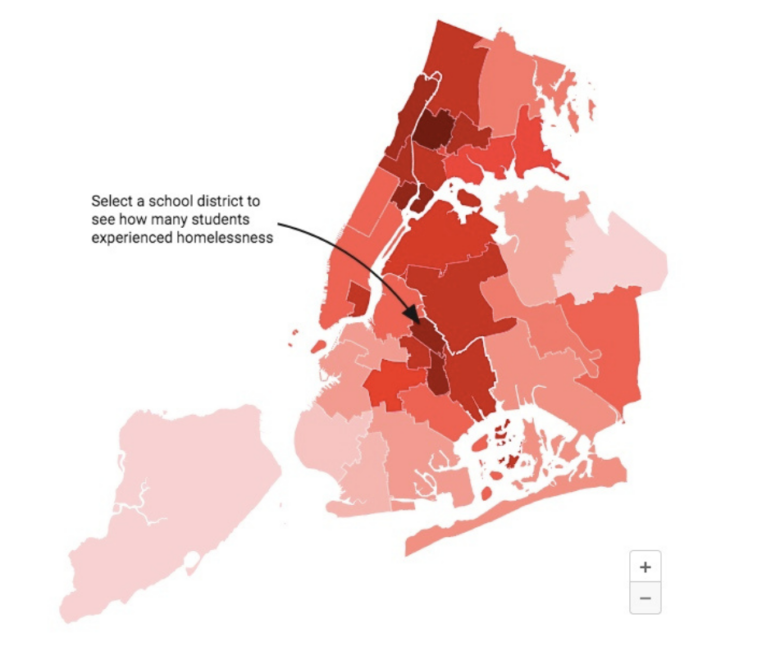
Demetrius Freeman/Mayoral Photography Office
Mayor Bill de Blasio marches in Sunday's St. Pat's for All Parade on Skillman Avenue in Queens.
Mayor de Blasio says he’ll honor the long-running boycott of the St. Patrick’s Day parade this year unless it becomes “more inclusive.” That’s a welcome announcement, and will help keep pressure on the parade to finally admit Irish LGBT groups. The parade organizers are seriously committed to exclusion: Even last year, when the loss of corporate sponsorships finally forced a reckoning, they still couldn’t bring themselves to talk with the handful of Irish LGBT groups who want to march. Instead, they cut a deal with another sponsor, NBC, to let their gay employees join the parade. (The move has been widely denounced as a cheap trick.)
De Blasio’s boycott alone may not be enough to end the discrimination, but he has the authority to do even more. The question of how to deal with the anti-gay parade has long been muddied by a 1993 court case refiguring it as a private, anti-gay Catholic procession. The mayor’s boycott of the parade obscures another problem: City Hall has long supported the parade organizers’ exclusion of Irish LGBT groups, and it hasn’t stopped yet. If negotiations are underway – the mayor hasn’t acknowledged them, but media reports have – then it’s time to set the record straight on these two legacies. And it’s time for the mayor to take the additional steps he can.
The St. Patrick’s Day parade is a deeply historic New York City event, begun in 1762 as a procession of Irish soldiers in the British army, some or all of whom would have been Protestant. Throughout its history, the parade has been used by political players to define Irishness to the exclusion of people they deemed embarrassing. The parade has banned women, people of color, people in wheelchairs, people supporting Irish republican prisoners, cars, animals and queers. (Irish LGBT people, though, are the only group that has never made it into the parade.) It’s historically an exclusionary parade reflecting New York Irish politics. But inherently Catholic? Certainly not.
Why does it matter that this 253-year-old parade is Irish, rather than Catholic? In 1993 the Irish Lesbian and Gay Organization had the parade organizers in court, challenging their right to discriminate in a public event. Contravening the NYC Human Rights Commission, the court ruled the parade a private event not subject to public anti-discrimination laws. The New York Times reported parade organizers’ view of the shift as “a victory of Catholic values over homosexuals.”
Indeed, conservative Catholics have a free-speech right to hold a discriminatory religious parade, just as others have a right to protest it. What they don’t have, though, is the right to demand a religious procession in place of New York’s historic Irish parade. As the Irish Voice wrote in 1993: “…the parade committee have asked parade participants to carry Rosary beads and pray as they walk up Fifth Avenue. In doing so they have reinforced the notion that the parade is a religious procession – a notion which is both at variance with the history of the parade, and which will serve to exclude most New Yorkers and many Irish Americans.”
If you’re wondering why the city has never stepped in to rescue the Irish parade from its decades of ignominy, you’ll need to know about the second legacy: city government’s long support for the parade’s homophobia.
ILGO first asked to march in 1990, but quickly realized they’d have to demand entry instead. Mayor Dinkins supported their protest. The NYPD did not. The legacy of Irish membership in the NYPD is strong, reinforced by an overlap in membership with the Ancient Order of Hibernians. (The AOH ran the parade until 2001, when it spun off an independent parade committee.) The Irish legacy also leaves strong connections with the Catholic Archdiocese, Irish-American fraternal and business organizations, unions, city departments and courts, all connected with the parade.
In 1991, the NYPD Emerald Society, a powerful fraternal organization counting several NYPD commissioners as members, passed a resolution opposing the inclusion of any “homosexual and alternative lifestyle” groups in the parade, and calling ILGO “perverts.” Ray Kelly, then a first deputy commissioner, was a member of the Emerald Society at the time. In 1996, Commissioner Bill Bratton denied ILGO a permit to protest the parade, partly on the spurious grounds that it couldn’t assure the safety of protesters. In 2010 Ray Kelly, having returned as NYPD commissioner, was the parade’s Grand Marshal and led the march. In 2011, when a dozen NYC LGBT groups asked Kelly to address community concerns about the parade’s contribution to anti-LGBT violence, he failed even to acknowledge the request. In 2014, similar letters to incoming Commissioner Bratton, then-FDNY Commissioner Salvatore Cassano and the mayor – signed by over 200 groups, city officials, attorneys, and community activists – also failed to get a response.
Uniformed NYPD and FDNY marching contingents make up about one third of the parade. Protesters on the sidelines have become accustomed to officers making obscene or threatening gestures as they march past (as in “You can march in a body bag.”) Police arrests for civil disobedience at the parade between 1991 and 2001 were also particularly violent, including some that led to settled claims against the NYPD. Cops making those arrests often verbally expressed their personal homophobia—and that the St. Patrick’s Day parade belonged to them. (Conversely, some arresting officers suggested they were unwilling participants in a vendetta. One officer said to me “I’m sorry to have to do this. It really isn’t my issue.”) These experiences were initially documented in Rock the Sham (2005). Although police aggression toward later years’ demonstrators is less frequent, it is still a regular experience.
The NYPD has been supported in its homophobic enthusiasm for the parade by each mayor since Dinkins. Mayor Giuliani marched unapologetically in the St Patrick’s Day parade, in keeping with his broader attacks on queer communities and people with AIDS. Mayor Bloomberg, perversely, always marched in the inclusive St. Patrick’s Day parade in Queens to support (or simply court) LGBT people. Then a few weeks later, Bloomberg always joined the discriminatory parade on Fifth Avenue, sometimes marching the route several times over.
When de Blasio was elected, many hoped City Hall would finally withdraw its support for the parade’s bigotry. LGBT groups first asked the mayor to take action on the letter NYPD Commissioner Kelly had ignored. Legal precedents hold that police officers who participate in public acts of discrimination are illegally curtailing equal access to policing, and the groups hoped de Blasio would withdraw NYPD contingents from the anti-gay parade to comply with the law. The mayor did not respond to the letter, but was confronted by a reporter asking the same question. In reply, he announced only that he would boycott the parade. He would not pull the NYPD contingents, he said, because he didn’t want to curtail city employees’ right to free expression.
De Blasio’s boycott triggered the sponsor boycott, which unmistakably breathed new life into the long-running protests of the parade. But his dodge on the question of uniformed NYPD participation in the parade was paper thin. Beyond the clear legal precedents, even the NYPD doesn’t claim that uniformed cops can engage in whatever speech they choose. The Patrol Guide says permission is required any time the uniform is worn outside regular functions, and commissioners have often prohibited cops from wearing uniforms in situations they don’t approve of. By refusing, de Blasio was signaling that his advocacy for “more inclusion” would be limited to personal acts; he would not use mayoral authority to withdraw city support from the parade.
Since the rise of tensions over police violence beginning last August, the situation has become more complicated. De Blasio’s relationship with the NYPD is tattered, so much that community groups who counted on the mayor’s help to redress police abuses are unsure what will come next. The mayor’s relationship with the Catholic Archdiocese is also much tighter. He has made overtures to religious institutions more broadly, with a campaign promise (yet unfulfilled) to end a ban on renting school space to religious groups, recruiting them heavily as universal pre-Kindergarten providers, and most recently allowing prayer breaks in publicly-funded pre-K, a nod to the Orthodox Jewish community that dismayed New Yorkers who prefer their church and state in separate packages. Religious voters contributed strongly to de Blasio’s sweep of the mayoral election, and he will need them to win a second term.
De Blasio’s support appears also to be limited to back channels. Community organizers working for decades to end the parade’s homophobia, initially instructed by de Blasio’s top staff to stay in close communication about the parade issue, can no longer get calls returned from City Hall. At the same time, insiders report that negotiation is underway between the mayor and the parade organizers. What can come out of these closed-door talks, undertaken on behalf of a community that is not allowed in? Given the City’s long practice of direct and tacit support for the parade’s discrimination, only a decisive withdrawal of support will bring change.
New Yorkers expect a St. Patrick’s Day parade each year, but it doesn’t have to be the same parade as the private Catholic march that currently assumes that role. As Dinkins did, this mayor can make clear that he’s willing to consider granting an Irish parade permit to a different applicant. He can withdraw the NYPD, FDNY and other city uniforms in recognition that the parade is an icon of exclusion. He has the authority to continue enabling the parade, or to stop.
Now we must be clear: This is not a conflict between a religious group’s right to run a discriminatory parade and pro-LGBT advocates’ demand to enter it. It’s the encroachment of the religious right into the public life of the city, including its police force and its top political figures. De Blasio has shown that he cares, and that’s important – because the success or failure of efforts to break the ban rests squarely with the mayor.









One thought on “Op-Ed: Mayor Must Reckon with St. Patrick’s Parade Legacies”
“the success or failure of efforts to break the ban rests squarely with the mayor.” It would help if the Church, the Irish Government and the sponsors told the organisers to get over it. Instead Dolan is Grand Marshal this year, Minister Flanagan will march and Diageo accepted the token Out@NBC participation.